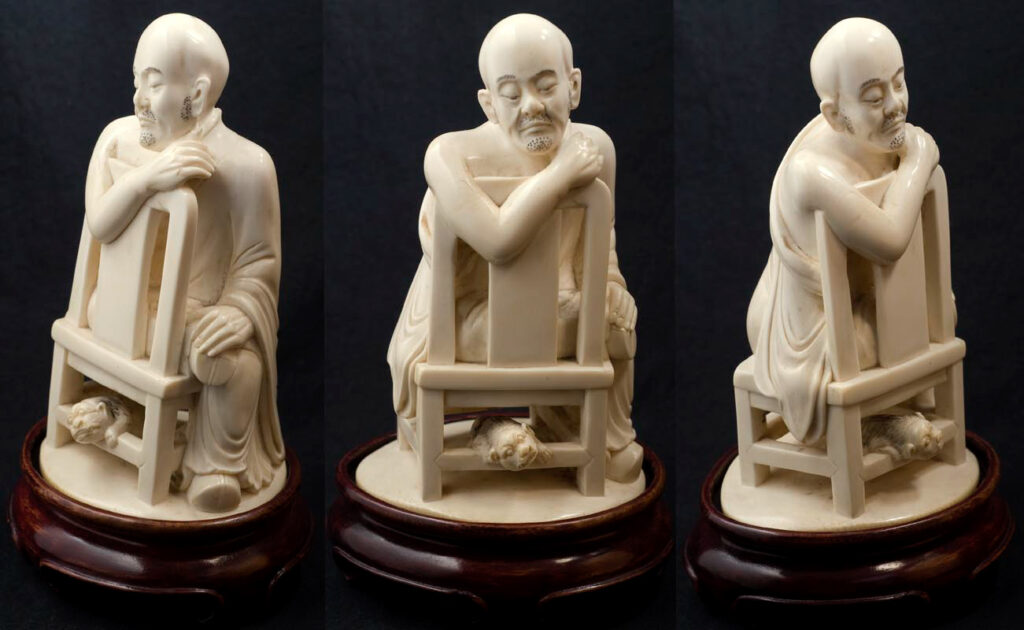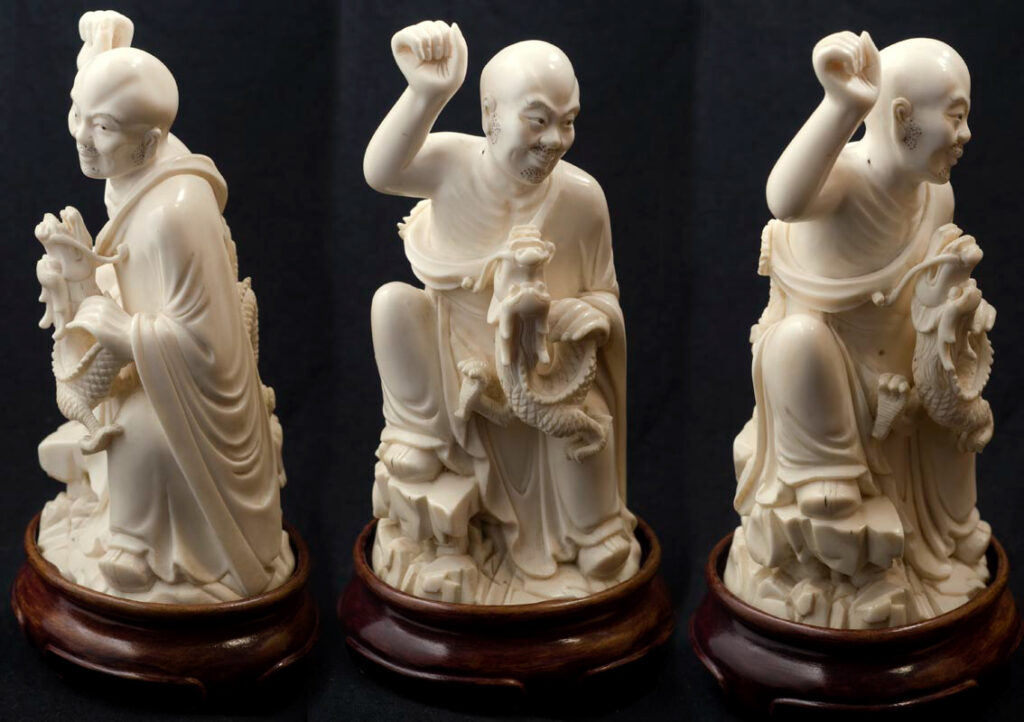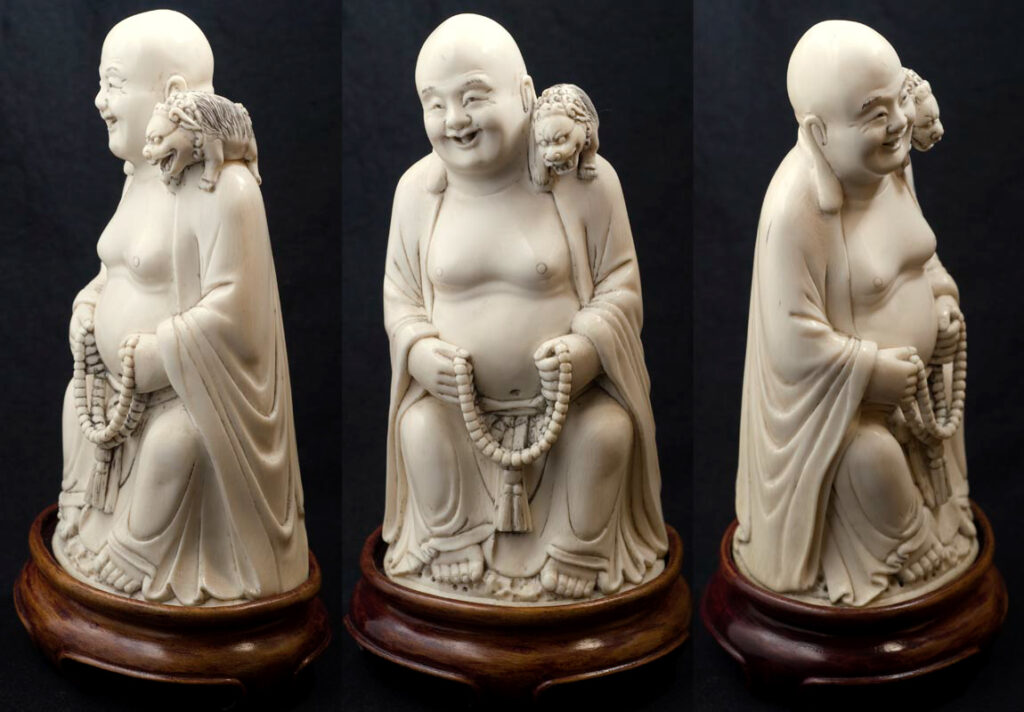Nefertari Pierre-Louis
Overview
The sacred temples of China, Korea, Japan and Tibet are spiritual spaces which house the beautifully sculpted Lohan of Chinese buddhist culture. Although scholars have preserved literature from the great monasteries of China, which mention only sixteen Lohan figures, there continues to be a traditional count of eighteen lined along the sacred halls of each temple. The Lohans (otherwise known as Arhats), are patrons and guardians of Sakyamuni Buddha’s system and are depicted in Chinese Buddhism as the original disciples of the great Gautama Buddha. Each Lohan has followed the Noble Eightfold Pathand and has attained the four stages of enlightenment. The tranquil depictions of the eighteen Arhats suggest they have reached Nirvana, the final goal of Buddhism in which there is a complete, peaceful absence of desire, suffering, and sense of self. Buddhas who reach Nirvana are also released from the effects of karma and the cycle of death and rebirth. This powerful state of enlightenment has prepared the Lohans to protect the Buddhist faith while waiting on earth for the coming of Maitreya.
This exhibition, Identifying The Eighteen Lohan of Buddhist Temples, highlights the importance of the Arhats in Chinese culture and strives to identify the significance of each Arhat and its characteristics. Identifying the eighteen Lohan is crucial to furthering our understanding of Chinese culture, asian art, and buddhism. The sculptures featured in this exhibition belong to Connecticut College’s Asian Art Collection.
In his work, The Eighteen Lohans, Professor Charles Egan writes, “The identities of most of the Eighteen Lohans here at Connecticut College are difficult to determine, because iconography changed greatly over time and became to some extent arbitrary, and also because Lohans were added or dropped from the roster with some frequency.” The Lohans which could be identified were analyzed in an attempt to better understand the collection as a whole. Pindola the Bhāradvāja, Nakula, Supāka, Angida, and Panthaka are the five Lohan presented in the exhibition. Various texts were used in the process of identifying the five sculptures, obtaining the most accurate representation of each Lohan required careful attention to detail. A few concerns regarding the correctness of each identification arose due to the fact that many of the Lohans were described in a similar way. Common descriptions often expressed that the Araht would be holding a book, accompanied by an animal (usually a tiger ), or meditating. Despite these commonalities, the ivory sculptures of Pindola the Bhāradvāja, Nakula, Supāka, Angida, and Panthaka were carefully identified.

Title: Lohan 1
Artist: Unidentified
Culture: Chinese
Medium: Ivory Sculpture
Dimensions: 7 x 4in
Repository: Connecticut College, New London
Description:
Lohan 1 is depicted in a relaxed state, sitting comfortably on a wooden chair. Like many of his buddhist companions, he fashions a cleanly shaved head. Beneath his chair is a small animal. I have identified this Lohan as Nakula, known also as Pakula or Vakula. Nakula was once a warrior of great strength, but relinquished his powers and his days of violence to become a monk. Through constant meditation he attained enlightenment. Nakula is often represented with a mongoose as his emblem, or a three-legged frog under his left arm. Sometimes he is meditating or teaching with a little boy beside him.

Title: Lohan 2
Artist: Unidentified
Culture: Chinese
Medium: Ivory Sculpture
Dimensions: 7 x 4in
Repository: Connecticut College, New London
Description:
Lohan 2 presents a subtle smile on his face, which is a common characteristic in Buddhist art. Contentment is a sign of enlightment. We see the powerful presence of a dragon staff in his left hand, dragons in Chinese culture symbolize great power, good luck and strength. The Lohan has long distinct eyebrows which set him apart from the others sculptures in our collection. Similar to most buddhas, Lohan 2 also has a shaved head. I have identified this Lohan as Pindola the Bhāradvāja, known also Long-Eyebrow Monk. Pindola is said to have excelled in occult and psychic powers. Although, he was once punished by the Buddha for misusing his socery to impress simple, ignorant people.

Title: Lohan 5
Artist: Unidentified
Culture: Chinese
Medium: Ivory Sculpture
Dimensions: 7 x 4in
Repository: Connecticut College, New London
Description:
Lohan 5 appears to be in good spirits, signifinging enlightenment. We see the meaningful presence of a dragon wrapped around his body, an important symbol in Chinese culture. Animals as emblems and pets continues to be a recurring theme amongst the lohan sculptures. Similar to most buddhas, Lohan 5 has a shaved head. I have identified this Lohan as Panthaka. Panthaka is the older brother of Chulapanthaka, the eleventh of the Sixteen Arhats. He was known as a remarkable scholar who taught hundreds of students. Panthaka, or Ta, strived to become an Arhat after listening to a monk explain the Buddha’s teaching of interdependent origination. After fufilling this goal, he carried on to teach Dharma widely.

Title: Lohan 7
Artist: Unidentified
Culture: Chinese
Medium: Ivory Sculpture
Dimensions: 7 x 4in
Repository: Connecticut College, New London
Description:
The sculpture of Lohan 7 contrasts the other Arhats in the collection with its stern facial expression and thin lines of hair. Lohan 7 sits cross-legged on a stone and firmly grips a tall book, he is accompanied by a deer-like animal. I have identified this Lohan as Supāka, known also as Gopaka (meaning the protector). Gopaka is often represented holding a large book to show his dedication to the buddhist teachings and his willingness to teach others. Gopaka is known to impart his knowledge of the arts, sciences and discriminating awareness, which enable his followers to teach the Dharma.

Title: Lohan 18
Artist: Unidentified
Culture: Chinese
Medium: Ivory Sculpture
Dimensions: 7 x 4in
Repository: Connecticut College, New London
Description:
The last and final Lohan documented in Connecticut College’s Asian Art Collection is Lohan 18. He is depicted as a round, jolly Arhat holding a long beaded necklace with a small creature on his left shoulder. I have identified this Lohan as Angida, he is not known by any other name. According to legend, Angida was an Indian snake-catcher whose aim was to prevent the snakes from biting passers-by. After the snakes were caught, he would remove the venomous fangs and then release them into the mountains. It was due to this kindness of heart that Angida was able to attain enlightenment.
Bibliography
Images
Connecticut College Asian Art Collections,
https://oak.conncoll.edu/visual/asian-art/shain-lohan/content/index.html.
Texts
Watters, Thomas. The Eighteen Lohan of Chinese Buddhist Temples. Shanghai [etc:
Kelly and Walsh, limited, 1899. Print.
Egan , Charles. The Eighteen Lohan: Chinese Carved Ivory Figurines, 18th Century Donated
to Connecticut College by Mrs. Kathryne C. Simons .
“The 18 Lohans .” 雲陽寺, https://www.yunyangtemple.org.au/australia/the-18-lohans.